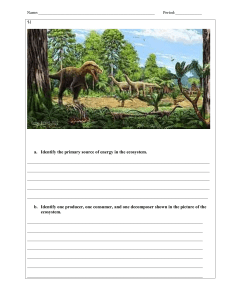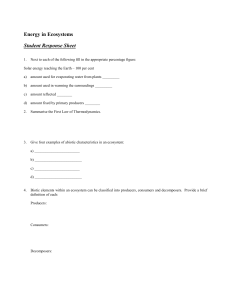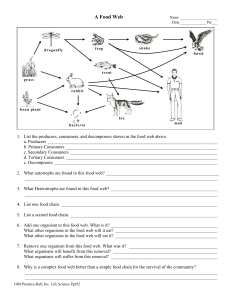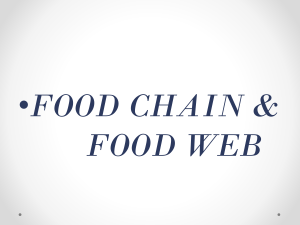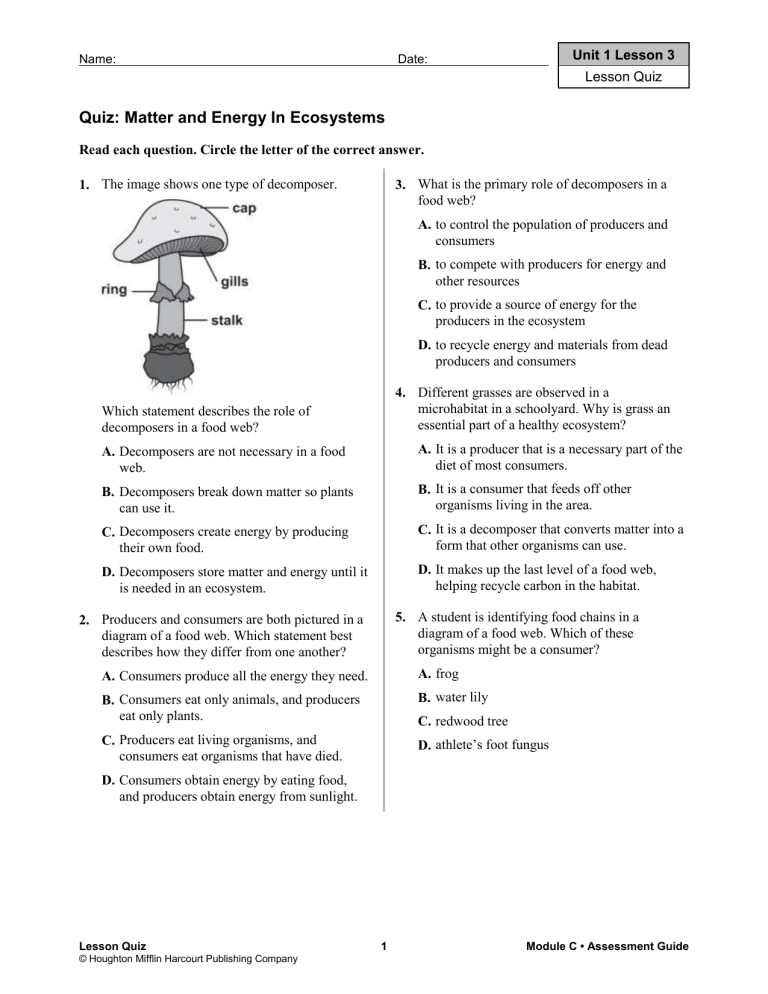
Name: Unit 1 Lesson 3 Date: Lesson Quiz Quiz: Matter and Energy In Ecosystems Read each question. Circle the letter of the correct answer. 1. The image shows one type of decomposer. 3. What is the primary role of decomposers in a food web? A. to control the population of producers and consumers B. to compete with producers for energy and other resources C. to provide a source of energy for the producers in the ecosystem D. to recycle energy and materials from dead producers and consumers 4. Different grasses are observed in a microhabitat in a schoolyard. Why is grass an essential part of a healthy ecosystem? Which statement describes the role of decomposers in a food web? A. Decomposers are not necessary in a food web. A. It is a producer that is a necessary part of the diet of most consumers. B. Decomposers break down matter so plants can use it. B. It is a consumer that feeds off other organisms living in the area. C. Decomposers create energy by producing their own food. C. It is a decomposer that converts matter into a form that other organisms can use. D. Decomposers store matter and energy until it is needed in an ecosystem. D. It makes up the last level of a food web, helping recycle carbon in the habitat. 5. A student is identifying food chains in a diagram of a food web. Which of these organisms might be a consumer? 2. Producers and consumers are both pictured in a diagram of a food web. Which statement best describes how they differ from one another? A. Consumers produce all the energy they need. A. frog B. Consumers eat only animals, and producers eat only plants. B. water lily C. Producers eat living organisms, and consumers eat organisms that have died. D. athlete’s foot fungus C. redwood tree D. Consumers obtain energy by eating food, and producers obtain energy from sunlight. Lesson Quiz © Houghton Mifflin Harcourt Publishing Company 1 Module C • Assessment Guide Name: Unit 1 Lesson 3 Date: Lesson Quiz 6. A mangrove swamp contains many organisms living among the large roots of the mangrove trees. The food web shows some of the relationships in that ecosystem. According to the food web, which organism is a producer in the mangrove swamp? A. mold B. prawn C. pelican D. phytoplankton 7. The figure shows a food chain that might exist in a meadow. If there was a decrease in the beetle population, how might the food chain be affected? A. The owl population would decrease. B. The population of green plants would decrease. C. The toad and snake populations would increase. D. The green plants and toad populations would decrease. Lesson Quiz © Houghton Mifflin Harcourt Publishing Company 2 Module C • Assessment Guide Name: Date: Unit 1 Lesson 3 Lesson Quiz Read each statement. Write your answer on the lines. 8. A biologist uses the terrarium shown to model the interactions of plants and animals in a forest ecosystem. Identify one benefit of using this model to study organism interactions. Identify one limitation of using this model to study organism interactions. 9. Summarize the carbon cycle. Based on the carbon cycle, hypothesize how the combustion of fossil fuels affects the amount of carbon dioxide in the ocean. Justify this hypothesis. Explain how this hypothesis could be tested. 10. A slug, frog, heron bird, and grass plant are all part of the same food chain. Through which process does energy get into the food chain? Which organisms are consumers in this food chain? Why would there be fewer herons in the ecosystem than slugs? Fungi are decomposers in this ecosystem. Where do they fit into the food chain? Explain. Lesson Quiz © Houghton Mifflin Harcourt Publishing Company 3 Module C • Assessment Guide
